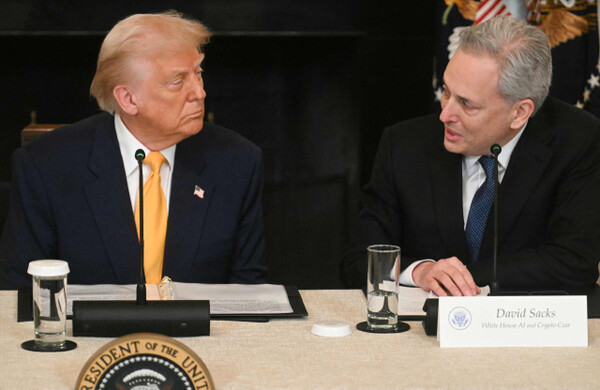
From the point of Donald Trump's 100th day in office on the 29th of last month, Bitcoin prices showed significant volatility, fluctuating from a high of $106,000 to a low of $76,000, a range of about $30,000. With Bitcoin recently recovering to the late $90,000 range, attention is focused on whether the market will enter a full-fledged upward phase. The market, which had been rising and falling without a clear policy direction, may also face a new turning point depending on the Trump administration's moves.
■Cryptocurrency 'Vertigo' Market
According to CoinMarketCap, a global virtual asset market site, as of 12 PM on the 2nd, Bitcoin rose 2.29% to $97,017. The total virtual asset market capitalization exceeded $3.02 trillion, with daily trading volume surpassing $33 billion. The news that MicroStrategy in the US purchased an additional 15,355 Bitcoins (about 2 trillion won) from the 21st to 27th of last month positively influenced investment sentiment.
Ethereum was at $1,848, Solana at $150, and Ripple at $2.22, with major altcoins also showing an upward trend. While the market sentiment indicator is at a neutral 55, 82% of investment communities are leaning towards a bullish market, maintaining an optimistic atmosphere.
Bitcoin prices began rapidly rising after Trump's re-election confirmation in November last year. Starting from the $70,000 range, it exceeded $85,000 in a single day and reached an all-time high of $106,000 in December. At the time, Trump's 'Bitcoin strategic reserve' statement and spot ETF fund inflows drove the upward trend.
However, when the Trump administration announced tariffs on Canada, China, and Mexico in February, the market turned sharply downward. Bitcoin dropped to around $93,000, with market capitalization evaporating by 230 trillion won in a day. Additionally, with the Bybit hacking incident, major altcoins like Ethereum and Ripple fell by over 20%.
Subsequently, disappointment over unclear digital asset policies, automobile tariff announcements, and interest rate uncertainties pushed Bitcoin down to the $74,000 level. Bitcoin recovered to the $90,000 range again only by the end of April.

■Strategic Assets and Stablecoins in Focus
As Trump's 100 days in office pass, attention is focused on whether the virtual asset market can successfully rebound. Particularly, the market is paying attention to the 'Strategic Bitcoin Reserve Asset' executive order signed by President Trump on March 6th. According to this order, Treasury Secretary Scott Bessent must submit a legal and investment review report detailing the establishment and operation of a Bitcoin strategic asset within 60 days of the order.
Kim Seung-min, head of Korbit Research Center, analyzed, "This executive order could bring the US federal government's Bitcoin purchase plan back to the surface" and "If the policy implementation becomes visible, its impact on Bitcoin prices will be significant."
He added, "With Visa and Mastercard recently starting stablecoin payment services, and major financial institutions like Morgan Stanley and JP Morgan actively launching virtual asset and blockchain platform services, the expanded participation of traditional financial sectors is a positive signal for the virtual asset ecosystem."
Experts point to stablecoins linked to physical assets like dollars and the US institutionalization movement as key variables that will determine market trends. The Gopax Research Center's recent report predicted that if stablecoin-related legislation passes the US Congress, it will have a critical impact on global payment systems and market liquidity. In fact, the US is promoting legislation to first nurture stablecoins issued by private entities over central bank digital currencies (CBDC).
Kim Dong-hwan, CEO of Wonderframe, emphasized the need to note that the US is making stablecoins a key means of its 'digital dollar' strategy. He stated, "The US can expand national bond demand through stablecoins and expect to circulate dollars in the global digital environment even if the Federal Reserve does not issue them" and "Stablecoins entering exchanges means an increase in standby funds, which essentially provides a market effect similar to lowering interest rates."







